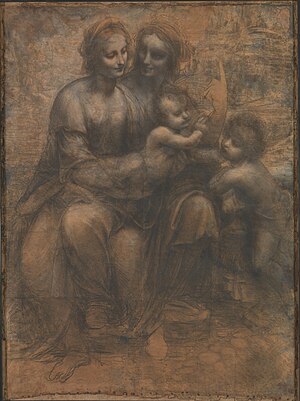Burlington House Cartoon
| The Virgin and Child with St Anne and St John the Baptist |
|
|---|---|
 |
|
| Artist | Leonardo da Vinci |
| Year | c. 1499–1500 or c. 1506–8 |
| Medium | charcoal, black and white chalk on tinted paper mounted on canvas |
| Dimensions | 141.5 cm × 104.6 cm (55.7 in × 41.2 in) |
| Location | National Gallery, London |
The Virgin and Child with St Anne and St John the Baptist, sometimes called The Burlington House Cartoon, is a drawing by Leonardo da Vinci. The drawing is in charcoal and black and white chalk, on eight sheets of paper glued together. Because of its large size and format the drawing is presumed to be a cartoon for a painting. No painting by Leonardo exists that is based directly on this cartoon.
The drawing depicts the Virgin Mary seated on the knees of her mother St Anne and holding the Child Jesus while St. John the Baptist, the cousin of Jesus, stands to the right. It currently hangs in the National Gallery in London. It was either executed in around 1499–1500, at the end of the artist's first Milanese period, or around 1506–8, when he was shuttling between Florence and Milan; the majority of scholars prefer the latter date, although the National Gallery and others prefer the former.
The subject of the cartoon is a combination of two themes popular in Florentine painting of the 15th century: The Virgin and Child with John the Baptist and The Virgin and Child with St Anne.
The drawing is notable for its complex composition, demonstrating the alternation in the positioning of figures that is first apparent in Leonardo's paintings in the Benois Madonna. The knees of the two women point different directions, with Mary's knees turning out of the painting to the left, while her body turns sharply to the right, creating a sinuous movement. The knees and the feet of the figures establish a strong up-and-down rhythm at a point in the composition where a firm foundation comprising firmly planted feet, widely spread knees and broad spread of enclosing garment would normally be found. While the lower halves of their bodies turn away, the faces of the two women turn towards each other, mirroring each other's features. The delineation between the upper bodies has lost clarity, suggesting that the heads are part of the same body.
...
Wikipedia
